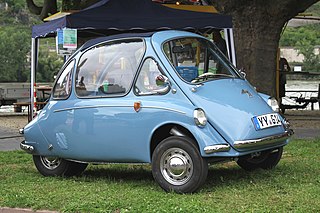
Microcar is a term often used for the smallest size of cars, with three or four wheels and often an engine smaller than 700 cc (43 cu in). Specific types of microcars include bubble cars, cycle cars, invacar, quadricycles and voiturettes. Microcars are often covered by separate regulations to normal cars, having relaxed requirements for registration and licensing.
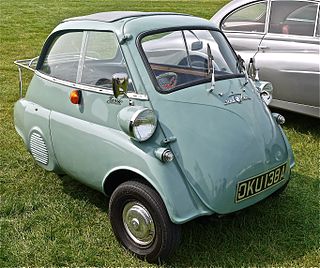
The Isetta is an Italian-designed microcar built under license in a number of different countries, including Argentina, Spain, Belgium, France, Brazil, Germany, and the United Kingdom. Because of its egg shape and bubble-like windows, it became known as a bubble car, a name also given to other similar vehicles.

The Bugatti Veyron EB 16.4 is a mid-engine sports car, designed and developed in Germany by the Volkswagen Group and Bugatti and manufactured in Molsheim, France, by French automobile manufacturer Bugatti. It was named after the racing driver Pierre Veyron.

Zündapp was a major German motorcycle manufacturer founded in 1917 in Nuremberg by Fritz Neumeyer, together with the Friedrich Krupp AG and the machine tool manufacturer Thiel under the name "Zünder- und Apparatebau G.m.b.H." as a producer of detonators. In 1919, as the demand for weapons parts declined after World War I, Neumeyer became the sole proprietor of the company, and two years later he diversified into the construction of motorcycles.

Motobécane was a French manufacturer of bicycles, mopeds, motorcycles, and other small vehicles, established in 1923. "Motobécane" is a compound of "moto", short for motorcycle; "bécane" is slang for "bike."

The Messerschmitt KR200, or Kabinenroller, is a three-wheeled bubble car designed by the aircraft engineer Fritz Fend and produced in the factory of the German aircraft manufacturer Messerschmitt from 1955 until 1964.
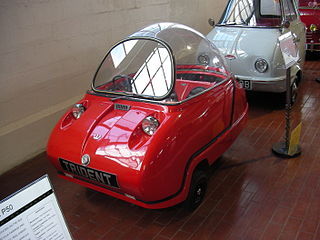
The Peel Trident is the second three-wheeled microcar built by the Peel Engineering Company on the Isle of Man. An all-new design from its one-seat counterpart the Peel P50, the Trident has two seats.

The Peel Engineering Company was a manufacturing company based in Peel on the west coast of the Isle of Man that primarily made fibreglass boats through its subsidiary company West Marine Ltd. and fairings for motorcycles.

A motorized bicycle is a bicycle with an attached motor or engine and transmission used either to power the vehicle unassisted, or to assist with pedalling. Since it sometimes retains both pedals and a discrete connected drive for rider-powered propulsion, the motorized bicycle is in technical terms a true bicycle, albeit a power-assisted one. Typically they are incapable of speeds above 52 km/h (32 mph), however in recent years larger motors have been built, allowing bikes to reach speeds of upwards of 72 km/h.
Trident Cars Ltd was a British car manufacturer based originally in Woodbridge, then in Ipswich, Suffolk between 1966 and 1974. The company produced a small series of sports cars with different engines from 1967 to 1977 and was later re-established in 1999.
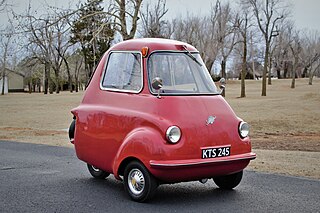
Scootacar was a British three-wheeled microcar built in Hunslet, Leeds by Scootacars Ltd a division of the railway locomotive builder, the Hunslet Engine Company between 1957 and 1964.
Egon Brütsch Fahrzeugbau, usually shortened to Brütsch, was a German automotive design and automaker based in Stuttgart, Baden-Württemberg.

The quadricycle is a European Union vehicle category for four-wheeled microcars, which allows these vehicles to be designed to less stringent requirements when compared to regular cars. Quadricycles are defined by limitations in terms of weight, engine power and speed.

A scooter is a motorcycle with an underbone or step-through frame, a seat, a transmission that shifts without the operator having to operate a clutch lever, a platform for the rider's feet, and with a method of operation that emphasizes comfort and fuel economy. Elements of scooter design were present in some of the earliest motorcycles, and motor scooters have been made since at least 1914. More recently, scooters have evolved to include scooters exceeding 250cc classified as Maxi-scooters.
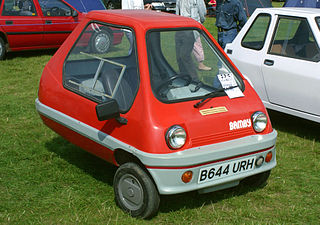
Bamby Cars was a British-built marque of microcars produced in small numbers in Hull, England, in the early 1980s. Bambys were designed and built by Alan Evans, who manufactured a one-off replica of the Peel P50 which also served as a prototype for further production.
Ze'ev "Zef" Eisenberg was the British founder of sports nutrition brand Maximuscle, an ultra-speed motorbike racer and television presenter.
ACOMA are a French microcar maker that operated between 1972 and 1984. The cars were designed by Émile Boussereau from Villeneuve-la-Comtesse and produced in Laval from 1970 to 1972 after which manufacturing moved to Saint-Barthélemy-d'Anjou, near Angers, until production stopped in 1984.















